Paper Mario: Sticker Star Review
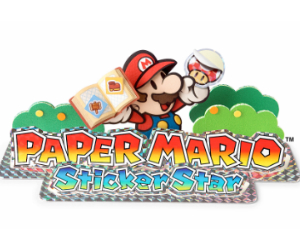 Game: Paper Mario: Sticker Star
Game: Paper Mario: Sticker Star
Developer: Intelligent Systems
Publisher: Nintendo
Available on: Nintendo 3DS Only
Most gamers will be familiar with the sight of Mario or Luigi careering through a traditional 2D or 3D platformer, but I wonder how many people have sampled the delights of guiding the plumbing duo through one of the very different Paper Mario titles? Building on ideas and conventions that had been first tried out in the Squaresoft/Nintendo crossover Super Mario RPG, Intelligent Systems kicked off their Paper series with the highly entertaining Paper Mario for Nintendo 64. It placed a cleverly animated paper-thin Mario into a 3D world, gave him a surprisingly deep role-playing system, including all of the battle/experience points you would expect, and sent him on a quest that was packed with wonderful characters, locations and, most importantly, a stack of knowing, self-referential, genuinely laugh-out-loud humour.
A brilliant Gamecube sequel refined the highly amusing turn-based adventure format even further – adding even more paper-related trickery to the environments and characters, and featuring some of the most impressive graphics for the maligned purple box. Rather than continue with the RPG style of their opening Paper brace, Intelligent Systems then switched things up for their Wii sequel Super Paper Mario, which did exactly what the title suggests, mixing up the kooky Paper universe with the platforming Super Mario of old. It had another rip-roaring script, a superb z-axis-flipping game mechanic, and a well-implemented score-based levelling up system. Like the two games that preceded it, Super Paper Mario was quite simply one of the finest first party offerings for the system it was released on.
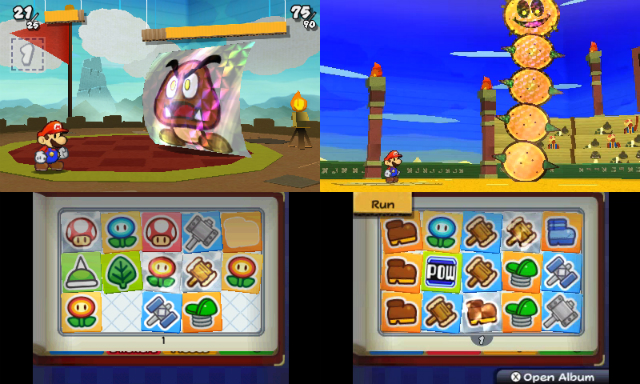
Nintendo have, in the 3DS, perhaps the perfect system for a game series that so often relies on using clever flippy mechanisms, skewed perspectives and depth of vision to reveal its secrets and create innovative gameplay. With Sticker Star, Nintendo have served up another game which deviates quite significantly away from the roots of the series. The result is a highly unusual, extremely compulsive handheld offering, that does not hit the same heights as Thousand Year Door, but repeatedly hammers your gaming sweet spot more often than not.
STORY: Unlike the previous games in the series, which had a rich, labyrinthine plot with stacks of dialogue, Sticker Star has a rather rudimentary plot that seems to exist solely as a reason to introduce the stickers that form the crux of the game. It won’t surprise you to hear that Bowser has once again kidnapped Princess Peach. The twist this time is that the spiked menace commits this foul deed during Decalburg’s annual Sticker Festival, a regular sticker-related shindig that coincides with the appearance of the magical Sticker Comet; a hunk of space debris that is said to have magical, wish-granting powers. Of course, Bowser decides he wants to dip his bread in this intergalactic gravy, which leads to an ugly fracas, with bits of comet being scattered all over the shop. One of the fragments lands on top of Bowser’s head, granting him untold power. The remaining comet segments – known as Royal Stickers – need to be retrieved from various locations in the Mushroom Kingdom. With the help of the talkative Kersti, a crown-shaped Sticker Fairy and arbiter of the Royal Stickers, Mario embarks on a quest to reunite the six precious stickers, save the Princess and once again give Bowser a good hiding.
GRAPHICS: It could be argued that what we have here is the best looking game yet released for the 3DS console. It is bright and colourful, just how you would expect a Paper Mario game to look. It still features characters that appear as though they are “cutouts” – 2D images that flip when they change direction – set against 3D backdrops. This time around there are some wonderful touches that give the enemies and NPCs even more papery charm during battles. Goombas will attack in mobs and form up into a large, papery square, or forgo spiked helmets and roll themselves up into a cone which will harm Mario if he jumps on it. Koopa Troopers literally “fold” themselves into shell form, whilst the Ninji make like origami, folding their bodies into shuriken stars. In a conventional role-playing game, or even a fighter, stunning a foe will result in them becoming dizzy, perhaps with some stars around their bonce. Not here, smashing an enemy good and proper will see them crumple like an unwanted chip wrapper.
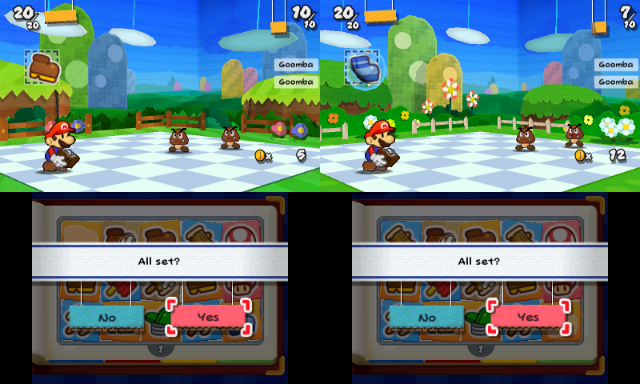
Imagination and humour permeates every nook and cranny of Sticker Star, and it’s nice to see that some of the locales are brand new creations rather than tired retreads. Case in point: the standard desert-themed areas of old – yeah there are pyramids in the background, Pokeys lurking in the quicksand and an abundance of cacti – yet this time there are some brilliant surprises. A huge Yoshi-shaped sphinx, some hieroglyphics that need to be seen to be believed, and a mariachi band made up of Shy Guys. A goddamn mariachi band! The game continues to make you smile from beginning to end. Some of the special attacks granted by certain stickers had me chuckling along like a loon, as did some of the shenanigans the baddies get up to. Goomba soldiers calling in a Bob-Omb airstrike using a trumpet? Check. Squadron of Paratroopas that act like Maverick and Goose in Top Gun? Yep.
The introduction of stereoscopic 3D enhances the Paper Mario experience tenfold, and some superb level design means that every single screen is a vibrant, gorgeous treat, literally teeming with possibilities and secrets. Stickers shine and flap tantalisingly, coercing you to peel them off. There are secrets hidden behind layers and layers hidden behind layers. It looks good enough to eat and everything is held together with a logical, sensible camera which always seems to find the right angle as you explore the world.
SOUND: Mario titles rarely disappoint with their catchy tunes. Paper Mario has something of a pedigree, with Thousand Year Door having one of the finest sets of ditties the moustachioed plumber has ever adventured to. Sticker Star does not always hit those sort of heights, but it does have some very cool, breezy, jazzy interpretations of classic Mario fare. The sound effects on the other hand are magnificent; from the satisfying sound of a sticker being lifted away from a piece of scenery, to the satisfying thwack of hammer on Goomba.
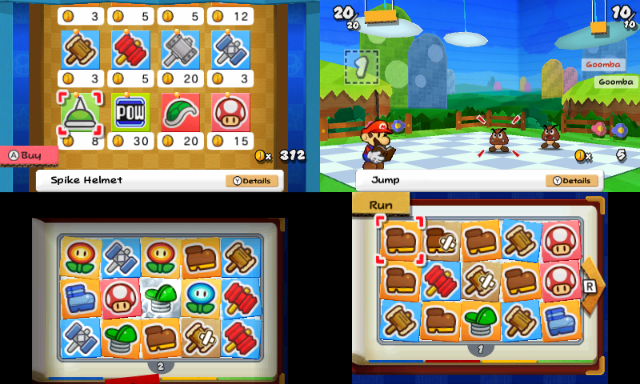
GAMEPLAY: When I mentioned that the gameplay was a bit of a departure from the earlier titles, I didn’t necessarily mean that the turn-based elements had been removed. In fact, they make a return after being ditched for Super Paper Mario. The difference is in the use of stickers, and the fact that the upgradeable stats have been simplified. You can increase your maximum hit points by seeking out “+5” hearts on your travels, but that is it. There are no buddy characters here either – this adventure sees Mario chance his arm in battle on his tod, with only his array of stickers to rely upon.
Mario has a sticker album used to store the many stickers found littered around the Mushroom Kingdom, whether they are stuck to the scenery, hidden inside “?” blocks, obtained from defeating foes, talking to NPCs or purchased in a shop. Rather than use attack/hit points, items or a block/defend function, each sticker corresponds to a particular command during battle. A Jump sticker is used to jump on an enemy. Hammer stickers are used to hit your enemies in a variety of different ways, depending on hammer type, Fire and Ice Flower stickers shoot projectiles in battle, and a Mushroom sticker will restore your HP. Most stickers have, like the attacks and moves in previous Paper Mario games, a rhythm action-style modifier that can prolong or boost the effectiveness of the action. Here, pressing A at just the right moment during the use of a Hopslipper or an Eekhammer will allow you to repeatedly bounce upon or bray your opponent into oblivion, respectively. The same principle is used in defence, hit A the moment a Goomba makes a play for your bonce and you will defend the attack, decreasing damage sustained.
Usually, you get the chance to use one sticker per turn, however, there is a fruit machine-like system that you can pay to use during each turn which can grant you extra sticker slots (up to a maximum of three) or even award a bonus. Line up three coins in a row, for example, and you will receive a nice monetary prize. The aim is to choose the right sticker for the job, whilst also keeping an eye on what stickers you have remaining, as once you run out you can no longer attack. Although you get an additional page in your sticker book each time you find a segment of the Comet Star, the book is still quite limited in size, meaning that, like Resident Evil 4, to give an outlandish but pertinent comparison, you only have enough space for a certain number of stickers. Some of them are larger than others too, so you do often find yourself having to jettison stickers in order to squeeze some of the bigger ones onto a page. Luckily, backtracking to re-obtain stickers you have used or binned is very simple thanks to the ease of moving around the world map and abundance of stickers throughout the land.
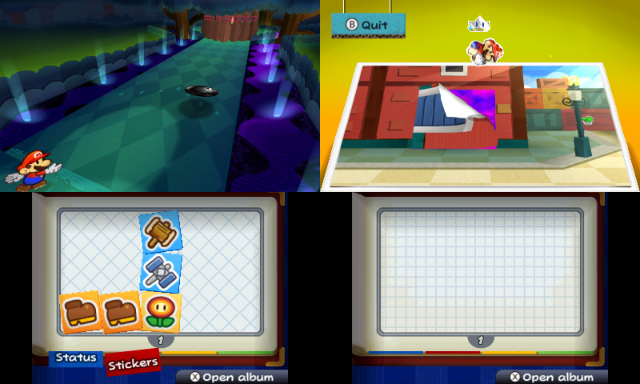
Starting out from Decalburg, Mario visits the many diverse areas of the land, each area consisting of five stages, culminating in a boss. There are some huge areas to conquer, many of which need to be revisited later on in order to eke out the many secrets and items. Along the way you have to interact with the locals, and solve puzzles using your power to “Paperize” – flattening down the screen and using stickers to manipulate the environment. Sometimes Paperizing is used to peel back errant sections of the screen and put them back in their rightful place, such as a doorway that has been rotated 90 degrees, or a bridge missing which needs to be put back. Most of the puzzles, however, require that you find one of the myriad “Things” dotted around the landscape. A Thing, you say? Well, when you first see one it will be blatantly obvious, as it will be the only object on the screen that doesn’t look like it is fashioned out of paper. Once you obtain a Thing, you can take it to a helpful Toad in Decalburg who will turn it into a sticker for you, which you can insert into the frames that appear during Paperization, indicating that a sticker is required. Sometimes these puzzles are very straightforward – such as using a Scissors sticker to cut the rope of a boat moored at the harbour – yet sometimes they make absolutely no sense at all. Why would you use a vacuum cleaner to combat a cyclonic sandstorm? Yet most of the time the crazy logic works, even if you cock things up and use the wrong sticker for the job, you can simply go back to Decalburg and visit the hilariously shady Things dealer and re-purchase the item. It also has to be said that some of the payoffs to using a Thing sticker are absolutely brilliant, fist pump to the air stuff. Don’t believe me? Check out what happens during the pleasingly named Whammino Mountain stage, where Mario sets off a completely insane Wallace & Grommit contraption-like chain reaction just by placing a sticker. There are plenty more smile-inducing moments like this.
The mixture of puzzling and turn based combat is, in theory, a great one, until you start to see the flaws that hinder what could have been a genuine classic. Obtuse puzzles aside, the lack of a bestiary or the ability to find out about the weaknesses and vulnerabilities of bosses and some stronger enemies can lead to you wasting your time – and your stickers – in a frustrating case of trial and error. I don’t expect to be led by the hand by any means, but sometimes the solutions to a problem are far from clear, therefore some more help would have been appreciated. Yes, Thing stickers are easy enough to obtain, but it would be nice to know that after a gruelling battle with a giant enemy, that your toil has not been in vain unless you own the one sticker that can finish him off. Was it too much to ask to have a Tattle sticker? On the flipside, most of the smaller enemies, particularly in the first three Worlds, are simply too easy to defeat using the same old stickers. Most foes can be taken out by using a Jump or Shiny Jump Sticker alone. Hitting the Battle lottery spin jackpot during any basic fight almost guarantees victory if you have enough stickers.
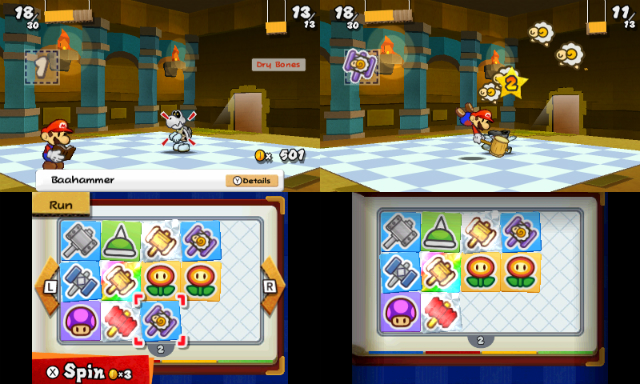
LONGEVITY: It will take most gamers about 20 hours tops to clear the main quest, which is perfectly presented to you in bite sized chunks just perfect for handheld gaming. As well as my longer sessions engrossed in the game, I found myself playing a level or two with a cup of coffee before work in the morning. It is utterly ideal in this respect, and very compulsive despite its flaws. There is an impressive amount of secret, hidden stuff; some of which is only revealed later in the game and involves plenty of backtracking (but in a good way). I loved the Sticker Museum, which asks you to provide an example of every sticker in the game, and plaster each one into the majestic Museum setting, which then doubles up as a handy guide to the tools available in your arsenal, each sticker you place there receiving a plaque telling you how it works and what its characteristics are. It is never a chore working your way through the many exploratory segments, battles and puzzles, because it is such a charming world in which to lose a few hours, with joyous surprises around every corner.
VERDICT: Part of me cant help wishing that Intelligent Systems had simply kept the Badge system from previous games, whilst introducing the Sticker mechanic to help solve puzzles and traverse the landscape. As it stands, the action stickers are literally everywhere – most of them respawning when you re-enter a stage – meaning that the game doesn’t really challenge you in that respect. Where are the rock hard enemies from Thousand Year Door, the lengthy tactical battles, the feeling of achievement when you found that rare badge?
This is still a tremendous handheld game, mind. The repetition and sometimes frustrating puzzling elements are completely hammered out of the way by the feelgood factor, that special Mario magic that keeps you playing to see what happens next. And this is a game that doesn’t even have a multi-layered plot to speak of, a la Thousand Year Door, which saw you taking control of ten different characters. It looks sublime, one of the finest looking games I have seen for many an age. It will be wonderful to see what Intelligent Systems can come up with now that they can harness the majesty of 1080p high definition.





